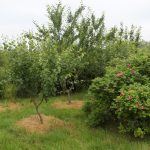
Preparing for the May '21 Sector39 PDC
The iconic garden behind me is from Ferme du Bec Hellouin, in Normandy. We were very inspired by their story at Oxford Real Farmers’ conference this year and have used some the insight gained for this years’ PDC at Treflach farm.
Perrine and Charles run this market garden in Normandy – France, but not your usual market garden: « we have started our project with the intention of exploring ecologically sound food growing practices, despite neither of us having previous experience of farming »
What you see is a small part of a bigger project, one which illustrates perfectly the potentials of permaculture design.
Permaculture design is a life long journey, the best way to begin this process is by investing in yourself.
- Time & Energy – make time available to give this course your full attention, it is a minimum of 72 hours study spread over your chosen study period.
- Planning & Visioning. Good questions to ask yourself at the outset are: What are my priorities, goals and ambitions from the PDC?
- What other resources do I have to commit to my own personal permaculture goals?
Things you will need:
- Note pads, pens, pencils and crayons for drawing.
- Laptop, computer or smart phone and a decent data connection
- All weather gear for field trips and farm explorations.
- Indoor shoes and warm clothes
- Bring your own personal preference items of food (if you have particular requirement), personal care items and cosmetics
- If camping make sure you have a decent tent and sleeping bag
- If you have any particular favorite reference books or digital resources to share
- Come with an open mind ready to learn new perspective, to share and be respectful and inclusive of the other course participants
- Permaculture designed systems run on feedback, so please stay in touch with our monitoring team during and after the course, helping us stay in touch of outcome and experiences.
Even if you are not able to have the on-far course experience, Treflach is always open to visitors and it is possible to arrange visits and guided tours at other times.

R’R
The middle Sunday is a day off. There are plenty of interesting places to visit locally for walks and exploration, Llanymynech rocks, Pistyll Rhaeadr, Cadair Berwyn, Penant Melangell, Vyrnwy Dam, to name a few
The PDC course strucutre
We choose to model our PDC timetable around David Holmgren’s 12 principles of permaculture, it provides a narrative thread and an easy way to recall the various steps in the design process.
The essence of Permaculture summary below is available for download in many languages below and offers a summary of each of those 12 principles. The PDC process begins and ends on the twelfth principle, which is about change.
Like the hours of a clock the principle 12 precedes principle 1, permaculture design begins with the recognition that the World is constantly changing, and Principle 12 invites us creative use and respond to change not to fight against it. Change may form patterns or seasons and is something that we can maybe influence but cannot ultimately control.
Here is a video explanation of the 12 principles from Oregon State University if you prefer to see it in this format.
Climate change
The Earth’s climate has always changed an is constantly evolving, however in the last 200 years the combustion of fossil fuels and the clearing of most of the planet’s forests has led to a rapid surge in CO2 levels in the atmosphere. Only a rapid reversal of this can resolve the problem.
In 2015 all the nations of the World signed the Paris Climate Accord which set a pathway to net-zero emissions, setting a series of clear targets which we already know we have to better. This video below offer an excellent exploration of this fundamental issue and sets into context what we must achieve to prevent run away and catastrophic climate change. A co-ordinated behavioral shift across the world is required, and we the people need to drag governments and the corporate role along with us as we see an ever deeper failing in global leadership. I do believe we can do this and that permaculture design is a powerful tool to help us achieve that end.

in 2019 S39 published this Permaculture handbook, it also serves a great accompaniment to the PDC. Written for schools and community it is an easily readable, fully illustrated 100 page book, free to download.
Bill Mollison and David Holmgren created the term Permaculture in the early 1970’s, to describe a system of permanent agriculture, that might give rise to permanent culture. Many people before them such as Japanese rice farmer Masanobu Fukuoka had already worked out way to farm with nature, as of course have most of the first nation cultures around the world. What Bill and Davis gave us was a lexicon, a design system and they set in motion what is now a global movement attempting to steer the world back onto a natural and regenerative footing.
Eston Mgala is a powerful advocate for Permaculture in Malawi. For him permculture’s approaches and observations resonate deeply with the Africa traditional experience.






